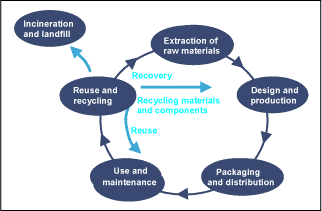|
Environmental Shareholder Value 4 Introduction to the company's environment4.1 The company's environmental impact This section describes what we understand by "the environment" and the environmental conditions relevant to the company - ie. the company's environment. We have decided to divide and describe the company's environment in three elements: the company's environmental impact, the company's environmental regulation and the company's environmental work. We made this division because it is primarily these three elements which, each in their own way, affect the financial situation of the company. 4.1 The company's environmental impactThe company's environmental impact can be divided into direct and indirect impacts. The direct impacts include the company's consumption of resources, as well as emissions, primarily from production. Companies with an obligation to prepare green accounts report on their direct environmental impacts in a mass balance with inputs of resources and outputs of emissions and waste. The indirect environmental impacts of the company include the impacts the company causes outside its premises and its direct activities. For example, this may be through choice of supplier, where a company can choose a supplier on the basis of environmental criteria. Other possibilities may be use and disposal of the company's products. If the company produces televisions, the amount of energy the televisions consume will be very significant, as well as how they are disposed of. Are they easy to disassemble, and can the material be used again? This type of consideration is the background to the lifecycle philosophy. Here, environmental impacts are calculated on the basis of the lifecycle of a product from extraction of raw materials to final disposal.
Figure 2: Lifecycle of the product The environmental impact of the company is to a large extent determined by what it does. The production and activities of the company are therefore crucial for its environmental impact. Some sectors have large environmental impacts, others small. Therefore, naturally the financial significance of the environment is also different from sector to sector. However, this generalisation does not always hold true. Despite being not particularly pollution intensive, some sectors, such as the telecommunications sector, still place high priority on environmental impacts because they can be a marketing parameter. 4.2 The company's environmental regulationThe scope of a company's environmental impact typically determines the amount of regulation it is subject to from the authorities. Therefore, in Denmark a number of companies are categorised as pollution intensive on the basis of the environmental impact of their production. For example, this may oblige them to have an environmental approval for production, and some must prepare annual green accounts for their environmental impact. A company's environmental approval stipulates a number of conditions to be met by the company's production. These may include noise restrictions or limitations on emissions of various pollutants. In other cases a company may only be permitted to produce a specific amount. So, environmental conditions establish the fundamental framework for the company's existence and how it may increase its volume of production. Furthermore, these conditions may mean that the company must invest in technology for air or wastewater treatment, or it may have to reorganise production processes. In addition to the conditions placed on the individual company, general environmental legislation on, for example, chemicals or waste will also be very important for the company. For example, this applies if a chemical vital for the company's processes is banned or if the company is subject to requirements to take back and recycle its waste. As well as the environmental regulations in legislation, there are a large number of environmental taxes with direct influence on the financial operation of the company. 4.3 The company's environmental workThe environmental impact of the company can be reduced through the company's environmental work. Initiatives may be forced on the company through legislation. However, many companies also work on environmental improvements voluntarily. Many companies have organised their environmental work in an environmental management system. Environmental management builds on a company working continuously on improving its environmental impact, and amongst other things it means that the company:
The company can work specifically to improve its environmental impact in a number of ways. In this respect there is a distinction between cleaning technologies and cleaner technology. Cleaning technologies include cleaning pollution using air filters or wastewater treatment plants, for example. These technologies are also called "end-of-pipe" technologies. In contrast to cleaning technologies, cleaner technology eliminates the environmental impact from the start. Cleaner technology can include:
Moreover, more and more companies are working with the product-oriented approach briefly described in section 4.1 on the lifecycle philosophy.
|
